Kamloops
| Kamloops | ||
|---|---|---|
| City | ||
| City of Kamloops | ||
 City view of Kamloops | ||
| ||
| Motto(s): Salus et Opes (Health and Wealth) | ||
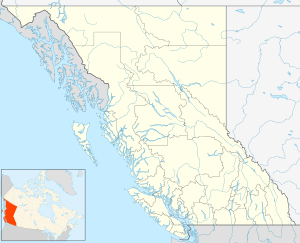 Kamloops Location of Kamloops in British Columbia  Kamloops Kamloops (Canada) | ||
| Coordinates: 50°40′34″N 120°20′27″W / 50.67611°N 120.34083°WCoordinates: 50°40′34″N 120°20′27″W / 50.67611°N 120.34083°W | ||
| Country |
| |
| Province |
| |
| Regions | Thompson Country | |
| District | Thompson-Nicola District | |
| Founded | 1811 (fur trading post) | |
| Incorporated | 1893 | |
| Government | ||
| • Type | Elected city council | |
| • Mayor | Ken Christian | |
| • Governing body | Kamloops City Council | |
| • MP | Cathy McLeod | |
| • MLAs |
Peter Milobar Todd Stone | |
| Area[1][2] | ||
| • Land | 299.23 km2 (115.53 sq mi) | |
| • Metro | 5,668.64 km2 (2,188.67 sq mi) | |
| Elevation[3][4] | 345 m (1,132 ft) | |
| Population (2016)[5][6] | ||
| • City | 90,280 | |
| • Density | 286.3/km2 (742/sq mi) | |
| • Metro | 103,811 | |
| • Metro density | 17.4/km2 (45/sq mi) | |
| Time zone | UTC−8 (PST) | |
| • Summer (DST) | UTC−7 (PDT) | |
| Forward sortation area | V1S, V2B - V2E, V2H | |
| Area code(s) | 250 / 778 / 236 | |
| Highways |
| |
| GNBC Code | JAFNW[7] | |
| NTS Map | 092I09[7] | |
| Website |
www | |
Kamloops (/ˈkæmluːps/) is a city in south-central British Columbia in Canada at the confluence of the two branches of the Thompson River near Kamloops Lake.
Kamloops is the Tournament Capital of Canada and hosts over 100 tournaments each year at world class sports facilities such as the Tournament Capital Centre, Kamloops Bike Ranch, and Tournament Capital Ranch. Tourism, education, and healthcare are major contributing industries to the regional economy and have grown in recent years.
Kamloops was British Columbia's first city to become a Bee City[8] in 2016 as numerous organisations in the community are actively to protect & create bumble bee habitats in the city.
It is the largest community in the Thompson-Nicola Regional District and the location of the regional district's offices. The surrounding region is more commonly referred to as the Thompson Country. It is ranked 37th on the list of the 100 largest metropolitan areas in Canada and represents the 44th largest census agglomeration nationwide, with 90,280 residents in 2016.[9] Kamloops has a regional district population of 132,663.[10]
Geography and Location
Kamloops is in the Thompson Valley and the Montane Cordillera Ecozone. The city's centre is in the valley near the confluence of the Thompson River's north and south branches. Suburbs stretch for more than a dozen kilometres along the north and south branches, as well as to the steep hillsides along the south portion of the city and lower northeast hillsides.
Robert W. Service in 1904 described Kamloops as his delightful life and wrote "Life was pleasant, and the work was light. At four o'clock we were on our horses, riding over the rolling ridges, or into spectral gulches that rose to ghostlier mountains. It was like the scenery of Mexico, weirdly desolate and aridly morose. A discouraging land, forbidding in its weariness and resigned to ruin."
Kamloops Indian Band areas begin just to the northeast of the downtown core but are not within the city limits. As a result of this placement, it is necessary to leave Kamloops' city limits and pass through the band lands before re-entering the city limits to access the communities of Rayleigh and Heffley Creek. Kamloops is surrounded by the smaller communities of Cherry Creek, Pritchard, Savona, Scotch Creek, Adams Lake, Chase, Paul Lake, Pinantan and various others.
History
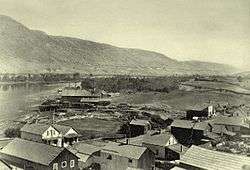
The first European explorers arrived in 1811, in the person of David Stuart, sent out from Fort Astoria, then still a Pacific Fur Company post, and who spent a winter there with the Secwepemc people, with Alexander Ross establishing a post there in May 1812 - "Fort Cumcloups".
The rival North West Company established another post - Fort Shuswap - nearby in the same year. The two operations were merged in 1813 when the North West Company officials in the region bought the operations of the Pacific Fur Company. After the North West Company's forced merger with the Hudson's Bay Company in 1821, the post became known commonly as Thompson's River Post, or Fort Thompson, which over time became known as Fort Kamloops.[11] The post's journals, kept by its Chief Traders, document a series of inter-Indian wars and personalities for the period and also give much insight to the goings-on of the fur companies and their personnel throughout the entire Pacific slope.
Soon after the forts were founded, the main local village of the Secwepemc, then headed by a chief named Kwa'lila, was moved closer to the trading post in order to control access to its trade, and for prestige and security. With Kwalila's death, the local chieftaincy was passed to his nephew and foster-son Chief Nicola, who led an alliance of Okanagan and Nlaka'pamux people in the plateau country to the south around Stump, Nicola and Douglas Lakes.
Relations between Nicola and the fur traders were often tense, but in the end Nicola was recognised as a great help to the influx of whites during the gold rush, though admonishing those who had been in parties waging violence and looting on the Okanagan Trail, which led from American territory to the Fraser goldfields.[12][13] Throughout, Kamloops was an important way station on the route of the Hudson's Bay Brigade Trail, which connected Fort Astoria with Fort Alexandria and the other forts in New Caledonia to the north (today's Omineca Country, roughly), and which continued in heavy use through the onset of the Cariboo Gold Rush as the main route to the new goldfields around what was to become Barkerville.
The gold rush of the 1860s and the construction of the Canadian Pacific Railway, which reached Kamloops from the West in 1883,[14] brought further growth, resulting in the City of Kamloops being incorporated in 1893 with a population of about 500. The logging industry of the 1970s brought many Indo-Canadians into the Kamloops area, mostly from the Punjab region of India. In 1973, Kamloops annexed Barnhartvale and other nearby communities.
Etymology
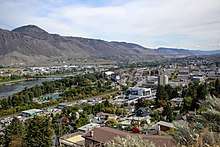

"Kamloops" is the anglicised version of the Shuswap word "Tk'əmlúps", meaning "meeting of the waters". Shuswap is still spoken in the area by members of the Tk'emlúps Indian Band.[15]
An alternate origin sometimes given for the name may have come from the native name's accidental similarity to the French "Camp des loups", meaning "Camp of Wolves"; many early fur traders spoke French.[11] One story perhaps connected with this version of the name concerns an attack by a pack of wolves, much built up in story to one huge white wolf, or a pack of wolves and other animals, traveling overland from the Nicola Country being repelled by a single shot by John Tod, then Chief Trader, thus preventing the fort from attack and granting Tod a great degree of respect locally.[16]
Industry
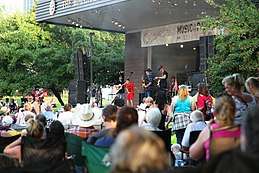
The Kamloops industry is diverse and includes healthcare, tourism, education, transportation and natural resource extraction.
Industries in the Kamloops area include primary resource processing such as Domtar Kamloops Pulp Mill, Tolko-Heffley Creek Plywood and Veneer, Highland Valley Copper Mine (in Logan Lake).
RIH (Royal Inland Hospital) is the city's largest employer. RIH is the region’s acute care and health facility and is one of two tertiary referral hospitals in the Southern Interior with 239 acute beds and an additional 20 more beds upon completion of the expansion in 2016.[17]
TRU (Thompson Rivers University) serves a student body of 25,754 including a diverse international contingent mainly from Asian countries.[18]Thompson Rivers University, Open Learning (TRU-OL) is the biggest distance education provider in British Columbia and one of the biggest in Canada.
Four major highways join in Kamloops, making it a transportation hub and a place which attracts business. There are over 50 trucking and transport companies located in Kamloops that ship across Canada and into the United States.[19] Both the Canadian Pacific Railway and the Canadian National Railway service Kamloops with both lines running through the city.[20]
Tourism

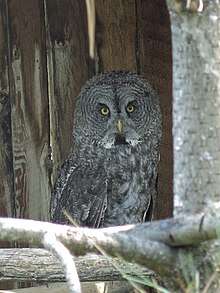
Kamloops welcomed 1.8 million visitors in 2017, a 9% increase from 2015 (1.64 million). Kamloops' unique and social, cultural and environmental resources are major tourism attractions.
Economic Overview
Tourism's economic ROI is immense. A $1.8 million destination marketing budget returned $449 million in economic benefit in 2017.The annual Direct Visitor Expenditure is estimated at $270 million, a 19% increase from 2015 ($227 million). Further, the total estimated tourism economic impact was $449 million in 2017, a 32.4% increase from 2015 ($339 million).[21]
Tourism generates many types of income for the region, including business income, wage earnings, share earnings, rates and levies. Conservation springs from industry-wide support for management, research and education initiatives that benefit everyone through responsible tourism management.
Accommodation
Kamloops has over 50 accommodation choices [22] from major hotels to bed and breakfasts. Accommodation occupancy rates were 61.5% in 2017,up 2.6% from 2016.
Attractions & Events
Popular attractions include: Adams River Sockeye Salmon Run; Kamloops Bike Ranch; BC Wildlife Park; Kamloops Heritage Railway; Kamloops Wine Trail; Secwepemc Museum, and Treetop Flyers.
Since 2012, four wineries have been established in the Thompson Valley wine region[23] including: Sagewood Winery; Harper's Trail Winery; Monte Creek Ranch Winery, and Privato Vineyard & Winery. Since 2010, three micro-breweries have opened up in Kamloops including: Noble Pig Brewhouse; Red Collar Brewing, and Iron Road Brewing.
Kamloops hosts a range of cultural events year-round including:
Kamloops Wine Festival: This annual festival is a fundraiser for the Kamloops Art Gallery.
Kamloops Film Festival: Since 1997, this festival has grown to celebrate international films at Paramount Theatre for 10 days in March.
River Beaver Classic: This annual, mountain biking festival hosts 4 events over 1 weekend in April with all money raised going to local trail maintenance.
Brewloops: Brewloops is a non-profit, beer, food, and bike festival that celebrates Kamloops culture with block parties on The Shore and Downtown throughout the year.
Kamloops International Buskers Festival: This 4 day festival takes place throughout Riverside Park and showcases professional buskers from around the globe.
Hot Nite in the City Show 'n' Shine: This weekend-long event takes place every August downtown and showcases Street Rods, Customs, American Muscle, Sport-compact, Electric Vehicles and more.
Kamloops Rotary Ribfest: Western Canada's largest rib festival, Ribfest takes place every August at Riverside Park. By 2018, Kamloops Rotary had raised over $500,000 for local charities.
Sport Chek Kamloops Marathon: Starting in 2012, this marathon has attracted athletes globally for it's 'fast and flat' course on the Rivers Trail, as well as being a Boston Marathon qualifier.
Salute to the Sockeye Festival: This festival celebrates the return of Sockeye Salmon to the Adams River at Tsútswecw Provincial Park from the end of September through mid-October each year.
Interior Wellness Festival: Since 2008, this event has promoted healthy living in BC including workshops with yogis, authors, and business experts.
Kamloops Comedy Fest: Canadian comedians take over the mic for a weekend each October during Kamloops Comedy Fest.
Sports
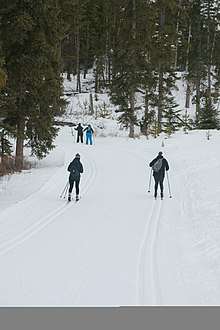
Kamloops is the Tournament Capital of Canada and is home to a range of professional athletes from many sports. The Tournament Capital has the Kamloops Sports Hall of Fame, which includes Bronze Medalist Dylan Armstrong and the National Finalist Roma's soccer team.[24]
Fishing
With 100 lakes within an hour's drive, Kamloops has some of the best freshwater fishing in North America. Every year, the Freshwater Fisheries Society of BC stocks lakes in the Thompson-Nicola region with roughly 1,000,000 with Rainbow Trout, Brook Trout, and Kokanee.
Kamloops is known for its professional anglers including Brian Chan, Jordan Oelrich, Brennan Lund. Fishing guides in the Kamloops area include: DNA Fly Fishing; Interior Fly Fishing; Maricle Fly Fishing; Riseform Flyfishing, and Fast Action Fishing Adventures.
Mountain Biking
Kamloops' extensive trail network and desert-like climate creates world class conditions for year-round mountain biking across the city. Popular parks include the Kamloops Bike Ranch; Pineview Valley; Lac du Bois Grasslands, and Kenna Cartwright Park. Two time World champion cross-country mountain biker and 2016 Olympic Bronze medalist Catharine Pendrel lives and trains in Kamloops.[25] Kamloops is home to world-famous mountain bikers such as freeride pioneers and Mountain Bike Hall of Fame members Wade Simmons, Brett Tippie, (also a former Canadian National Team member for snowboard cross and giant slalom), Richie Schley.Freeriders Matt Hunter, and Graham Agassiz also live in Kamloops.[26] Kamloops was featured in the first mountain bike film by Greg Stump, "Pulp Traction", and later the first three "Kranked" films, which starred the original Froriders, Tippie, Simmons and Schley.
Ongoing trail maintenance has been spearheaded by local organisations such as the Kamloops Bike Riders Association, Kamloops Performance Cycling Centre, and Dirt Chix Kamloops.
Golf
Kamloops has highest number of golf courses (13) per capita in Canada and boasts one of Canada's most diverse golf landscapes.Golfers enjoy a three-seasons golf season due to the dry and hot climate of the area.[27] Several of the local golf courses have been designed by famous golf architects such as Robert Trent Jones Sr., Graham Cooke, and Thomas McBroom.[27]
The 13 courses include: Tobiano Golf Course; The Dunes,Talking Rock Golf Course; Pineridge Golf Course; Rivershore Estates; Big Horn Golf & Country Club; Kamloops Golf & Country Club; Sun Peaks Golf; Eagle Point Golf Course; Mount Paul Golf Course, and Chinook Cove Golf.[28]
Hockey
Kamloops is home to the Western Hockey League's Kamloops Blazers who play at the Sandman Centre. Alumni of the Kamloops Blazers include Mark Recchi, Jarome Iginla, Darryl Sydor, Nolan Baumgartner, Shane Doan, Scott Niedermayer, Rudy Poeschek and Darcy Tucker (Recchi, Doan, Iginla, and Sydor are now part-owners of the club). Two-time champion coach Ken Hitchcock would later win the Stanley Cup with the Dallas Stars.
Kamloops is also the hometown of 2015 World Junior Ice Hockey Champion and current defenceman for the Detroit Red Wings, Joe Hicketts.[29]
On February 6, 2016, Kamloops hosted Hockey Day in Canada with Ron MacLean and Don Cherry.[30]
Skiing
Sun Peaks Resort is a nearby ski and snowboard hill. Olympic medallist skier Nancy Greene is director of skiing at Sun Peaks and the former chancellor of Thompson Rivers University. The Overlander Ski Club runs the Stake Lake cross country ski area with 50 km (31 mi) of trails.
Lacrosse teams include the Thompson Okanagan Junior Lacrosse League's Kamloops Junior B Rattlers, as well as the Kamloops Storm. Also calling Kamloops home is the Canadian Junior Football League's Kamloops Broncos, and Pacific Coast Soccer League's Kamloops Excel, both of whom play at Hillside Stadium.
Sports tournaments

Kamloops hosted the 1993 Canada Summer Games. It co-hosted (with Vancouver and Kelowna) the 2006 IIHF World U20 Championship from 26 December 2005, to 5 January 2006. It hosted the 2006 BC Summer Games and 2018 BC Winter Games. In the summer of 2008, Kamloops, and its modern facility the Tournament Capital Centre, played host to the U15 boys and girls Basketball National Championship.
Kamloops hosted the World Masters Indoor Championships 2010 on 1–6 March 2010.[31]
Kamloops hosted the 2011 Western Canada Summer Games.
Kamloops hosted the 2014 Tim Hortons Brier (The Canadian Men's Curling Championships).[32]
Kamloops hosted the 2014 4 Nations Cup.[33]
Other recreation
The Kamloops Rotary Skatepark at McArthur Island Park is one of Canada's largest skateboard parks.[34] Also located at McArthur Island Park is NorBrock Stadium, the McArthur Island Sports and Events Centre and the McArthur Island Curling Club. The city boasts 82 parks which are great for hiking, including Kenna Cartwright Park, the largest municipal park in British Columbia.[35]
Culture
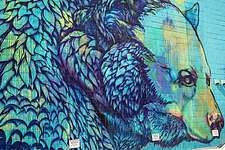
Kamloops culture has grown in recent years to celebrate local talent that includes: culinary arts, sports, live entertainment, and fine art.
Performing Arts & Fine Art
Kamloops is home to many galleries including nationally recognized Kamloops Art Gallery,[36] Secwepemc Museum & Heritage Park; The Kamloops Museum & Archives, the Kamloops Symphony Orchestra,[37] and Western Canada Theatre.
There are 29 outdoor murals - the Back Alley Art Gallery- throughout downtown Kamloops that the Kamloops Central Business Improvement Association has spearheaded since the 2000s. Artists that have contributed to this project include: Zack Abney; Kyleen Cachelin; Evan Christina; Kelly Wright; Ken Wells; Alex Moir-Porteus; Robin Hodgson; Jack Morris; Janice Gurney, and Marianna Abutalipova.
The Western Canada Theatre is a professional theatre company located in Kamloops. The company manages and performs in two spaces: the 706 seat Sagebrush Theatre and the 150-seat Pavillion Theatre. James MacDonald is the current Artistic Director of the Theatre company.[38] Previous Artistic Directors include Tom Kerr, Frank Glassen, David Ross, Michael Dobbin, John Cooper, and Jeremy Tow.[39]
Food & Drink
Since 2007, Chefs in the City has been established as a "celebration of culinary arts, fine wine and beer from Kamloops and the surrounding region.[40]" In 2018, 21 local restaurants will participated, as well as 10 local wineries and breweries. This annual event is presented by the Rotary Club of Kamloops and has raised over $325,000 since 2007.
Kamloops is emerging as an award winning wine region with a climate perfect for growing grapes. It is home to four award winning wineries: Harper's Trail, Monte Creek Ranch, Privato and Sagewood.[41] Kamloops has over 120 acres under vine. The top grapes planted by local wineries are Riesling, Chardonnay, Pinot Gris, Pinot Noir, Cabernet Franc, Marechal Foch and Marquette.
Since 1998, the Kamloops Wine Festival has taken place in the spring as a fundraiser to support the Kamloops Art Gallery. The Kamloops Wine Festival had raised over $200,000 by 2018.[42]
In 2014, Brewloops Beer Festival was established as a non-profit organization that promotes Kamloops culture across the city throughout the year. Brewloops celebrates BC craft beer, music, and entertainment with the wider Kamloops community and had donated $27,000 to community groups by 2018.[43] Bands that have performed at Brewloops include: Dehli 2 Dublin, Yukon Blonde, and At Mission Dolores.
Transportation
Kamloops is located at the crossroads of the Coquihalla Highway, Yellowhead Highway, and Trans-Canada Highway and is a transportation hub in the region.
The Canadian Pacific (CPR) and Canadian National (CNR) mainline routes connect Vancouver in the west with Kamloops. The two railways diverge to the north and east where they connect with the rest of Canada. Kamloops North railway station is served three times per week (in each direction) by Via Rail's Canadian.
Kamloops is home to Kamloops Airport (YKA). Airlines flying to Kamloops include: Air Canada Express, WestJet Encore, Canadian North, and Central Mountain Air, as well as three cargo airlines. In 2018, Air Canada Rouge launched its direct flight from Kamloops to Toronto.[44]
Greyhound Canada previously connected Kamloops with Vancouver, Edmonton and Calgary, with service ending at the end of October 2018.
Local bus service is provided by BC Transit with 18 routes across the Kamloops area. In 2018, the City of Kamloops partnered with the Tk'emlups te Secwepemc to expand its services on Tk'emlups te Secwepemc land for Route 18: Mount Paul Route.[45]

Climate

The climate of Kamloops is semi-arid (Köppen climate classification BSk) due to its rain shadow location. Because of milder winters and aridity, the area west of Kamloops in the lower Thompson River valley falls within Köppen climate classification BWk climate. Kamloops gets short cold snaps where temperatures can drop to around −20 °C (−4 °F) when Arctic air manages to cross the Rockies and Columbia Mountains into the Interior.

The January mean temperature is −2.8 °C (27 °F).[46] That average sharply increases with an average maximum temperature of 4.3 °C (40 °F) in February. The average number of days where temperatures drop below` −10 °C (14 °F) per year is 19.9 as recorded by Environment Canada.[46]
Although Kamloops is above 50° north latitude, summers are warmer than in many places at lower latitudes, with prevailing dry and sunny weather. Daytime humidity is generally under 40% in the summer, sometimes dropping below 20% after a dry spell, which allows for substantial nighttime cooling. Occasional summer thunderstorms can create dry-lightning conditions, sometimes igniting forest fires which the area is prone to.
Kamloops lies in the rain shadow leeward of the Coast Mountains and is bio geographically connected to similar semi-desert areas in the Okanagan region, and a much larger area covering the central/eastern portions of Washington, Oregon and intermontane areas of Nevada, Utah and Idaho in the US.
These areas of relatively similar climate have many distinctive native plants and animals in common, such as ponderosa pine (Pinus ponderosa), big sagebrush (Artemisia tridentata), prickly pear cactus (Opuntia fragilis in this case), rattlesnakes, black widow spiders and Lewis's woodpecker.
The highest temperature ever recorded in Kamloops was 41.7 °C (107 °F) on 27 July 1939 and 16 July 1941.[47][48] The coldest temperature ever recorded was −38.3 °C (−37 °F) on 16 & 18 January 1950.[49]
| Climate data for Kamloops Airport, 1981–2010 normals, extremes 1890–present[lower-alpha 1] | |||||||||||||
|---|---|---|---|---|---|---|---|---|---|---|---|---|---|
| Month | Jan | Feb | Mar | Apr | May | Jun | Jul | Aug | Sep | Oct | Nov | Dec | Year |
| Record high humidex | 15.8 | 17.0 | 23.3 | 31.9 | 36.8 | 39.0 | 47.4 | 40.3 | 38.4 | 31.2 | 22.8 | 15.0 | 47.4 |
| Record high °C (°F) | 16.1 (61) |
17.8 (64) |
23.3 (73.9) |
33.3 (91.9) |
37.8 (100) |
39.1 (102.4) |
41.7 (107.1) |
40.8 (105.4) |
35.0 (95) |
31.3 (88.3) |
22.8 (73) |
16.1 (61) |
41.7 (107.1) |
| Average high °C (°F) | 0.4 (32.7) |
4.3 (39.7) |
11.0 (51.8) |
16.6 (61.9) |
21.5 (70.7) |
25.1 (77.2) |
28.9 (84) |
28.3 (82.9) |
22.3 (72.1) |
13.7 (56.7) |
5.6 (42.1) |
0.3 (32.5) |
14.8 (58.6) |
| Daily mean °C (°F) | −2.8 (27) |
0.1 (32.2) |
5.2 (41.4) |
9.9 (49.8) |
14.6 (58.3) |
18.4 (65.1) |
21.5 (70.7) |
20.9 (69.6) |
15.6 (60.1) |
8.5 (47.3) |
2.1 (35.8) |
−2.7 (27.1) |
9.3 (48.7) |
| Average low °C (°F) | −5.9 (21.4) |
−4.0 (24.8) |
−0.6 (30.9) |
3.2 (37.8) |
7.7 (45.9) |
11.6 (52.9) |
14.2 (57.6) |
13.4 (56.1) |
8.8 (47.8) |
3.3 (37.9) |
−1.4 (29.5) |
−5.8 (21.6) |
3.7 (38.7) |
| Record low °C (°F) | −38.3 (−36.9) |
−32.8 (−27) |
−26.1 (−15) |
−10.6 (12.9) |
−5.6 (21.9) |
0.6 (33.1) |
3.3 (37.9) |
0.6 (33.1) |
−3.9 (25) |
−17.1 (1.2) |
−30.0 (−22) |
−36.1 (−33) |
−38.3 (−36.9) |
| Record low wind chill | −42.0 | −36.7 | −33.9 | −13.0 | −5.2 | 0.0 | 0.0 | 0.0 | −6.5 | −23.2 | −39.1 | −45.1 | −45.1 |
| Average precipitation mm (inches) | 21.1 (0.831) |
12.4 (0.488) |
12.8 (0.504) |
14.2 (0.559) |
27.3 (1.075) |
37.4 (1.472) |
31.4 (1.236) |
23.7 (0.933) |
29.4 (1.157) |
19.4 (0.764) |
23.3 (0.917) |
25.4 (1) |
277.6 (10.929) |
| Average rainfall mm (inches) | 5.3 (0.209) |
5.9 (0.232) |
9.7 (0.382) |
14.0 (0.551) |
27.3 (1.075) |
37.4 (1.472) |
31.4 (1.236) |
23.7 (0.933) |
29.4 (1.157) |
19.0 (0.748) |
14.2 (0.559) |
7.1 (0.28) |
224.3 (8.831) |
| Average snowfall cm (inches) | 18.7 (7.36) |
8.0 (3.15) |
3.5 (1.38) |
0.2 (0.08) |
0.0 (0) |
0.0 (0) |
0.0 (0) |
0.0 (0) |
0.0 (0) |
0.3 (0.12) |
10.9 (4.29) |
21.9 (8.62) |
63.5 (25) |
| Average precipitation days (≥ 0.2 mm) | 9.7 | 7.2 | 6.8 | 6.2 | 10.2 | 10.7 | 8.4 | 8.0 | 7.6 | 9.0 | 10.0 | 11.7 | 105.6 |
| Average rainy days (≥ 0.2 mm) | 3.6 | 3.8 | 5.5 | 6.1 | 10.2 | 10.7 | 8.3 | 8.0 | 7.6 | 8.8 | 7.1 | 3.4 | 83.3 |
| Average snowy days (≥ 0.2 cm) | 7.6 | 4.1 | 1.9 | 0.3 | 0.0 | 0.0 | 0.0 | 0.0 | 0.0 | 0.3 | 3.9 | 9.3 | 27.4 |
| Average relative humidity (%) | 72.6 | 60.0 | 43.0 | 35.6 | 36.2 | 36.4 | 33.5 | 34.4 | 41.4 | 52.9 | 65.9 | 70.9 | 48.6 |
| Mean monthly sunshine hours | 55.2 | 95.6 | 165.3 | 202.8 | 251.6 | 252.0 | 303.4 | 289.5 | 223.3 | 130.9 | 63.7 | 46.6 | 2,079.8 |
| Percent possible sunshine | 20.9 | 33.9 | 45.0 | 49.0 | 52.4 | 51.2 | 61.2 | 64.3 | 58.7 | 39.2 | 23.5 | 18.6 | 43.2 |
| Source: Environment Canada[46][50] | |||||||||||||
| Hottest summer | Most days above 30 °C (86 °F) | Driest | Warmest spring | Fewest fog days | Most sunny days in warm months | Most growing degree days | Most days without precipitation | ||||||
|---|---|---|---|---|---|---|---|---|---|---|---|---|---|
| Rank among 100 largest Canadian cities | 1st | 1st | 2nd (next to Whitehorse) | 2nd (next to Chilliwack) | 2nd (next to Penticton) | 2nd (next to Portage la Prairie) | 3rd (next to Windsor and St. Catharines-Niagara) | 3rd (next to Medicine Hat and Lethbridge) | |||||
| Value | 27.43 °C (81.4 °F) | 32.8 | 277.63 mm (10.93 in) | 9.65 °C (49.4 °F) | 7.28 | 148.93 | 2308.61 | 258.12 | |||||
| Data[51] is for Kamloops Airport (YKA), in the city of Kamloops, 5 NM (9.3 km; 5.8 mi) west northwest of the town.[4] | |||||||||||||
Demographics
| Historical population | ||
|---|---|---|
| Year | Pop. | ±% |
| 1881 | 200 | — |
| 1891 | 1,500 | +650.0% |
| 1901 | 1,359 | −9.4% |
| 1911 | 3,772 | +177.6% |
| 1921 | 4,501 | +19.3% |
| 1931 | 6,167 | +37.0% |
| 1941 | 5,959 | −3.4% |
| 1951 | 8,099 | +35.9% |
| 1956 | 9,096 | +12.3% |
| 1961 | 10,076 | +10.8% |
| 1966 | 10,759 | +6.8% |
| 1971 | 26,168 | +143.2% |
| 1976 | 58,311 | +122.8% |
| 1981 | 64,048 | +9.8% |
| 1986 | 61,773 | −3.6% |
| 1991 | 67,057 | +8.6% |
| 1996 | 76,394 | +13.9% |
| 2001 | 77,281 | +1.2% |
| 2006 | 80,376 | +4.0% |
| 2011 | 85,678 | +6.6% |
| 2016 | 90,280 | +5.4% |
| Sources: Statistics Canada[52][53] | ||
| Canada 2016 Census | Population | % of Total Population | |
|---|---|---|---|
| Visible minority group Source:[54] |
South Asian | 2,455 | 2.8% |
| Chinese | 1,220 | 1.4% | |
| Japanese | 820 | 0.9% | |
| Filipino | 675 | 0.8% | |
| Arab | 175 | 0.2% | |
| Black | 550 | 0.6% | |
| Korean | 230 | 0.3% | |
| Southeast Asian | 235 | 0.3% | |
| Latin American | 310 | 0.4% | |
| West Asian | 75 | 0.1% | |
| Other visible minority | 55 | 0.1% | |
| Mixed visible minority | 175 | 0.2% | |
| Total visible minority population | 6,975 | 8% | |
| Aboriginal group Source:[55] | First Nations | 4,830 | 5.5% |
| Métis | 3,495 | 4% | |
| Inuit | 15 | 0% | |
| Total Aboriginal population | 8,600 | 9.8% | |
| European | 71,765 | 82.2% | |
| Total population | 87,340 | 100% | |
Demographics of the City of Kamloops according to Statistics Canada 2016 census.[56]
|
|
Religious groups
Data is from the 2001 census.[57]
|
|
Ethnic Chinese
Kamloops historically had a Chinatown on Victoria Street where most ethnic Chinese lived. John Stewart of the Kamloops Museum & Archives stated it was not a "true Chinatown".[58] It was established by Chinese immigrants by 1887, and by 1890 the community had up to 400 Chinese. Stewart said this was an "amazingly large" population for the rural area.[59] By the 1890s, about 33% of Kamloops were ethnic Chinese; they worked primarily on construction of the Canadian Pacific Railway.[60]
Economic changes in Kamloops resulted in many Chinese seeking work elsewhere. In addition, there were two fires in 1892 and 1893, and a 1911-1914 demolition that dismantled the Chinatown.[61] Peter Wing, the first ethnic Chinese mayor in North America, was elected in 1966 and served three terms as the Mayor of Kamloops.[60]
A Chinese cemetery was founded in Kamloops, the only one in the province dedicated to Chinese pioneers.[60] It is one of the largest cemeteries in the province,[60] but the last interment was made there in the 1960s.[62]
In 2013 the provincial government announced it would begin a consultation process to discuss wording of a formal apology to Chinese in B.C. for past wrongs. Joe Leong, president of the Kamloops Chinese Cultural Association, said he believed that the province should build a museum to honor Chinese history in the province, as a way to recognize the contributions of the people. As Kamloops had the only cemetery dedicated to the Chinese pioneers, he felt this city would be an appropriate site for the museum.[60]
Media
Education
K-12
Public schools in Kamloops and adjacent communities are run by School District 73 Kamloops/Thompson.
Private schools include Kamloops Christian School, Our Lady of Perpetual Help School (Catholic), and St. Ann's Academy (Catholic).
The Conseil scolaire francophone de la Colombie-Britannique operates one Francophone school: école Collines-d’or primary school.[63]
Post-secondary
Thompson Rivers University[64] offers a range of undergraduate and graduate degrees as well as certificate and diploma programs. It has satellite campuses in
Thompson Rivers University also has an open-learning division. Thompson Rivers University, Open Learning (TRU-OL) is the biggest distance and online education provider in British Columbia and one of the biggest in Canada.
Thompson Career College and Sprott Shaw College are private post-secondary institutions with campuses in Kamloops.
Neighbourhoods
Officially recognised neighbourhoods within the city of Kamloops.[65]
Unofficially recognized areas are listed beneath the neighbourhoods to which they belong:
|
|
|
Notable people
Below is a list of people who are from Kamloops, or who lived there for an extended period.
Historical figures
- Lillian Beattie, early Kamloops educator and founder of the Kamloops Select School.
- Edward Donald Bellew, recipient of the Victoria Cross.
- Jim Chamberlin, aerodynamicist, who contributed to the design of the Canadian Avro Arrow; NASA's Project Mercury, Gemini spacecraft and the Apollo program.
- Kanao Inouye, the notorious "Kamloops Kid", the first of the two Canadians ever convicted of war crimes.
- Allan McLean, son of Donald McLean and leader of the outlaw gang known as the Wild McLean Boys.
- Donald McLean, former Chief Trader of Fort Kamloops and one of the casualties of the Chilcotin War.
- Frank Robert Miller, former Deputy Minister of National Defence.
- Chief Nicola, conjoint chief of the Nicolas and the Kamloops Shuswap during the fur trade and gold rush eras.
- John Fremont Smith A pioneer settler of Kamloops a Black Caribbean from the Danish West Indies served as Indian agent.
- Mary Spencer (photographer), notable early Kamloops photographer.
- Johnny Ussher, settler, provincial magistrate and Gold Commissioner (killed by Allan McLean)
- Mark Sweeten Wade, medical doctor, newspaperman and historian.
Politicians
- Kenna Cartwright, first and only female Mayor of Kamloops.
- Jack Davis, politician who was elected both federally and provincially.
- Jodie Emery - marijuana activist and politician
- John L. Frazer, politician: member of the House of Commons of Canada from 1993 to 1997.[66]
- Edmund Davie Fulton, politician: member of the Canadian House of Commons from 1945 to 1963, and 1965 to 1968.[67]
- Phil Gaglardi, aka Flying Phil, former Provincial Minister of Highways and Mayor of the city.
- Leonard Marchand, QPC, CM, the first person of First Nations ethnicity to serve in the federal cabinet and the first Status Indian to serve as a Member of Parliament.[68][69]
- Nelson Riis, former Kamloops alderman and Director of the Thompson-Nicola Regional District, later federal MP for Kamloops.
- Peter Wing, North America's first elected mayor of Chinese descent, elected in 1966 and served three terms in Kamloops.[70]
- Meryl Matthews, politician and first women given the honour "Freedom of the City."
Athletes
- Graham Aggasiz, Freeride mountain biker, top qualifier at RedBull Rampage 2013 and 2014,[71]
- Catharine Pendrel, Cross Country Mountain Biker, 2016 Olympic Bronze Medalist, 2011 and 2014 World Champion[25]
- Dylan Armstrong, Olympic shotputter who finished 4th in the 2008 Olympics but subsequently was awarded the bronze medal in 2015 after the 3rd place putter Andrei Mikhnevich from Belarus tested positive for drugs post 2008 Olympics
- Corryn Brown, Canadian curler, skip of the 2013 Canadian Junior Curling Championships winning rink, 2012 Winter Youth Olympics Bronze Medalist.[72]
- Don Ashby, former NHL ice hockey player[73]
- Joe Hicketts, 2015 World Junior Ice Hockey Champion, Detroit Red Wings Defenceman[74]
- Murray Baron, former NHL ice hockey player[75]
- Jim Cotter (curler), Canadian curler, 2013 Olympic Trials runner up, 2014 Tim Hortons Brier silver medalist.[76]
- Mitch Berger, NFL player[77]
- Josie Morrison, Canadian speedskater, 2018 Winter Olympian[78]
- Rick Boh, former NHL ice hockey player[79]
- Craig Endean, former NHL ice hockey player[80]
- Todd Esselmont, ice and roller hockey player
- Erin Gammel, is a swimmer who competed at the 2004 Summer Olympics
- Nancy Greene, Named Canada's Athlete of the Century in 1999, Olympic skier who won gold for Canada in 1968, and 13 World Cups (the Canadian record) for a total of 17 Canadian Title Championships[81]
- Stu Grimson, former NHL ice hockey player[82]
- Don Hay, former NHL head coach[83]
- Jessica Hewitt, short track speed skater, silver medalist at 2014 Sochi Olympics
- Murray Kennett, is a former WHA ice hockey player[84]
- Doug Lidster, former NHL ice hockey player[85]
- Steve Marr, ice hockey defenceman.[86]
- Bert Marshall, former NHL ice hockey player[87]
- Spencer McLennan, Former CFL football player
- Don Moen, Former CFL football player
- Bob Mowat, former WHA ice hockey player[88]
- Shane Niemi, is a Canadian sprinter
- Kelly Olynyk, Miami Heat and Canada international basketball player
- Paul Osbaldiston, Former CFL football player
- Rudy Poeschek, former NHL player.
- Kevin Powell, former CFL football player
- Mark Recchi, former NHL ice hockey player and Stanley Cup Champion (1991, 2006, 2011)[89]
- Justin Ring, former CFL football player
- Peter Soberlak, former AHL professional ice hockey player[90]
- Dave Vankoughnett, former CFL football player
- Tim Watters, former NHL ice hockey player[91]
Arts, culture and media
- Benjamin Ayres, actor, born in Kamloops
- Dan Bremnes, Christian musician, born in Kamloops
- Steven Galloway, novelist, was raised in Kamloops
- Elise Gatien, actress
- Boris Karloff, actor, joined the Jeanne Russell theatre company in Kamloops in September 1911
- Chris Masuak, Punk rock singer-songwriter Australian Music Hall of Famer, born in Kamloops - lived in Brocklehurst (North Kamloops) in the 1960s. Now resides in Spain.
- John Pozer, award-winning filmmaker
- Robert W. Service, poet and writer known for his ballads depicting the Klondike Gold Rush of 1897, he worked at Kamloops branch of the Canadian bank of commerce from July to December 1904 before being transferred to Whitehorse.[92]
- Michael Shanks, actor, born in Vancouver, but grew up in Kamloops[93]
- Lawrence Paul Yuxweluptun, First Nations painter
Other notable people
- Andrew Collier, commander of the Royal Canadian Navy.
- Lesra Martin, resident lawyer who helped with Rubin "The Hurricane" Carter's prison release.[94]
- Mildred Gottfriedson, first First Nations individual inducted into the Order of Canada and founding member of the B.C. Native Women's Society
- Nadine Caron, first female First Nations surgeon
- Vivian Dowding, leading birth control activist
Politics
Elections into the municipality in Kamloops are held with the rest of the province every four years.
Provincially, Kamloops is considered to be bellwether, having voted for the governing party in every provincial election since the introduction of parties to British Columbian elections, until 2017. By contrast, Kamloops has regularly voted against the party in power federally until the 2006 Federal election. Kamloops is represented in two provincial ridings – Kamloops and Kamloops-North Thompson – and one federal riding – Kamloops—Thompson—Cariboo.
- Mayor – Ken Christian
- Members of the Legislative Assembly:
- Todd Stone, Kamloops-South Thompson
- Peter Milobar, Kamloops-North Thompson
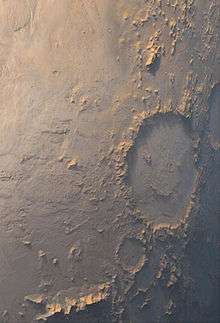
Federal Members of Parliament:
- Cathy McLeod (2008–present) Conservative Party of Canada
- Betty Hinton (2000–2008) Conservative Party of Canada
- Nelson Riis (1980–2000) New Democratic Party
- Don Cameron (1979–1980) Progressive Conservative Party of Canada
- Leonard Marchand (1968–1979) Liberal Party of Canada
Planetary nomenclature
The city's name has been given to a crater on the surface of Mars. Crater Kamloops was officially adopted by the International Astronomical Union's Working Group for Planetary System Nomenclature (IAU/WGPSN) in 1991. The crater lies at 53.8° south latitude and 32.6° west longitude, with a diameter of 65 km (40 mi).[95][96]
Sister cities
In media
In "Cementhead," a 1989 episode of the television series Booker, the titular detective (played by Richard Grieco) tracks a capricious professional hockey player (Stephen Shellen) back to his hometown of Kamloops.
Kamloops and surrounding areas have been used for various Hollywood films such as An Unfinished Life, The A Team, 2012, The Pledge, Shooter, Firewall, The Sisterhood of the Travelling Pants, Monster Trucks (film), and various others.[98]
"The Eye of Jupiter", the eleventh episode of the third season of Battlestar Galactica was filmed in Kamloops in 2006.
See also
References
- ↑ Kamloops Community Profile - Statistics Canada. 2006 Community Profiles.
- ↑ Kamloops, British Columbia (Census agglomeration)
- ↑ Elevation at the airport
- 1 2 Canada Flight Supplement. Effective 0901Z 19 July 2018 to 0901Z 13 September 2018.
- ↑ Population and Dwelling Count Highlight Tables, 2016 Census – Census subdivisions
- ↑ Population and Dwelling Count Highlight Tables, 2016 Census – Census metropolitan areas and census agglomerations
- 1 2 Natural Resources Canada Mapping Services
- ↑ "City of Kamloops | Bee City status".
- ↑ Canada. Statistics Canada. "Census Profile 2016". Retrieved 9 March 2017.
- ↑ http://www.venturekamloops.com/why-kamloops/community-profile/demographics
- 1 2 "Kamloops". BC Geographical Names.
- ↑ Fort Kamloops Journals, various authors (traders), primary source.
- ↑ History of the Okanagan Chiefs in James Teit, The Shuswap People, vol XII of the Papers of the Jesup North Pacific Expedition
- ↑ City of Kamloops - History of Kamloops
- ↑ Tk'emlúps Indian Band, Tk'emlúps History, 2011. Accessed 2011-06-01.
- ↑ Fur and Gold: Stories, Tales and Legends of British Columbia, John Pearson, undated S.K. Press Holdings, undated., White Rock, B.C.
- ↑ "Healthcare - Venture Kamloops - Economic Development for the City of Kamloops". venturekamloops.com. Retrieved 2018-10-09.
- ↑ https://www.tru.ca/about/facts.html
- ↑ "Transportation & Logistics - Venture Kamloops - Economic Development for the City of Kamloops". venturekamloops.com. Retrieved 2018-10-09.
- ↑ "Transportation & Logistics - Venture Kamloops - Economic Development for the City of Kamloops". venturekamloops.com. Retrieved 2018-10-09.
- ↑ "2017 Tourism Kamloops Annual Report" (PDF).
- ↑ "Accommodation | Tourism Kamloops".
- ↑ "Thompson Valley | Wines of British Columbia".
- ↑ "Kamloops Sports Council - Recipients" (PDF).
- 1 2 "Catharine Pendrel", Wikipedia, 2018-09-09, retrieved 2018-09-25
- ↑ Santa Cruz Sentinel
- 1 2 "Kamloops Golf Courses | BC Golf Vacations British Columbia". Golf in British Columbia. Retrieved 2018-09-25.
- ↑ "Tourism Kamloops | Golf".
- ↑ "Joe Hicketts", Wikipedia, 2018-10-08, retrieved 2018-10-09
- ↑ http://www.sportsnet.ca/kamloops-bc-to-host-2016-scotiabank-hockey-day-in-canada/
- ↑ Kamloops World Masters Athletics 2010 - Canadian Athlete Entries
- ↑ "2014 Tim Hortons Brier", Wikipedia, 2018-01-08, retrieved 2018-09-25
- ↑ "4 Nations Cup", Wikipedia, 2018-09-18, retrieved 2018-09-25
- ↑ Kamloops Rotary Skatepark
- ↑ "Tourism - Venture Kamloops - Economic Development for the City of Kamloops". venturekamloops.com. Retrieved 2018-10-09.
- ↑ Kamloops Art Gallery
- ↑ Kamloops Symphony Orchestra
- ↑ "Artistic Director - | Western Canada Theatre". www.wctlive.ca. Retrieved 2018-10-09.
- ↑ "Western Canada Theatre", Wikipedia, 2018-06-10, retrieved 2018-10-09
- ↑ "Chefs in the City | Info".
- ↑ "Artistic Director - | Western Canada Theatre". www.wctlive.ca. Retrieved 2018-10-09.
- ↑ "CFJC News | Kamloops Wine Festival".
- ↑ "About | Brewloops".
- ↑ "YKA | YYZ-YKA Flight".
- ↑ "KTW | Route 18 Mount Paul".
- 1 2 3 "Kamloops A" (CSV (8222 KB)). Canadian Climate Normals 1981–2010. Environment Canada. Climate ID: 1163780. Retrieved 2014-01-15.
- ↑ "Daily Data Report for July 1939". Environment Canada. Retrieved 13 February 2013.
- ↑ "Daily Data Report for July 1941". Environment Canada. Retrieved 13 February 2013.
- ↑ "Daily Data Report for January 1950". Environment Canada. Retrieved 23 April 2016.
- ↑ "Kamloops". Environment Canada. Retrieved 23 April 2016.
- ↑ - from
- ↑ Belshaw, John (2009). Becoming British Columbia: A Population History. ISBN 9780774815451.
- ↑ "British Columbia – Municipal Census Populations (1921–2011)". BC Stats. Retrieved 9 May 2013.
- ↑ "Community Profiles from the 2011 Census, Statistics Canada - Census Subdivision". 2.statcan.gc.ca. 6 December 2010. Retrieved 2013-04-13.
- ↑ "Aboriginal Peoples - Data table". 2.statcan.ca. 6 October 2010. Retrieved 2013-04-13.
- ↑ - Statistics Canada. 2016 Community Profiles.
- ↑ Kamloops Community Profile - Statistics Canada. 2001 Community Profiles.
- ↑ Stewart, John (Kamloops Museum & Archives). "Chinatown in Kamloops" (Archive). City of Kamloops. p. 1. Retrieved on 26 January 2015.
- ↑ Stewart, John (Kamloops Museum & Archives). "Chinatown in Kamloops" (Archive). City of Kamloops. p. 4. Retrieved on 26 January 2015.
- 1 2 3 4 5 Hewlett, Jason. "Chinese museum would right historical wrongs, Kamloops group says" (Archive). Times Colonist. 31 October 2013. Retrieved on 26 January 2015.
- ↑ Stewart, John (Kamloops Museum & Archives). "Chinatown in Kamloops" (Archive). City of Kamloops. p. 5. Retrieved on 26 January 2015.
- ↑ Stewart, John (Kamloops Museum & Archives). "Chinatown in Kamloops" (Archive). City of Kamloops. p. 3. Retrieved on 26 January 2015.
- ↑ "Carte des écoles." Conseil scolaire francophone de la Colombie-Britanique. Retrieved on 22 January 2015.
- ↑ Thompson Rivers University
- ↑ Maps By Neighbourhood
- ↑ PARLINFO - Parliamentarian File - Federal Experience - FRAZER, John L. (Jack), O.M.M., M.S.C., C.D
- ↑ PARLINFO - Parliamentarian File - Federal Experience - FULTON, The Hon. Edmund Davie, P.C., O.C., Q.C.LL.B., LL.D
- ↑ Leonard Marchand: The first Status Indian elected to Canada's Parliament Archived 29 October 2007 at the Wayback Machine.
- ↑ Federal Political Biography from the Library of Parliament
- ↑ "Former Kamloops mayor dies at 93". Times-Colonist. 31 December 2007. Archived from the original on 3 November 2012. Retrieved 2008-04-16.
- ↑
- ↑ "Corryn Brown", Wikipedia, 2018-09-17, retrieved 2018-09-25
- ↑ Don Ashby hockey statistics & profile at hockeydb.com
- ↑ "Joe Hicketts", Wikipedia, 2018-10-08, retrieved 2018-10-09
- ↑
- ↑ "Jim Cotter (curler)", Wikipedia, 2018-04-09, retrieved 2018-09-25
- ↑ Mitch Berger
- ↑ "Josie Morrison", Wikipedia, 2018-04-07, retrieved 2018-10-09
- ↑ Rick Boh hockey statistics & profile at hockeydb.com
- ↑ Craig Endean hockey statistics & profile at hockeydb.com
- ↑ http://www.peaksmedia.com. "Official Web Site of Nancy Greene Canadian Olympic Champion Skier". Nancy Greene. Retrieved 2013-06-15.
- ↑ "NHL Player Search - Player - Stu Grimson". Legends of Hockey. Retrieved 2013-06-15.
- ↑ Don Hay hockey statistics & profile at hockeydb.com
- ↑ Murray Kennett hockey statistics & profile at hockeydb.com
- ↑ Doug Lidster hockey statistics & profile at hockeydb.com
- ↑ Steve Marr hockey statistics & profile at hockeydb.com
- ↑ Bert Marshall hockey statistics & profile at hockeydb.com
- ↑ Bob Mowat hockey statistics & profile at hockeydb.com
- ↑ "Mark Recchi Stats and News". NHL.com. Retrieved 2017-08-03.
- ↑ Peter Soberlak hockey statistics & profile at hockeydb.com
- ↑ Tim Watters hockey statistics & profile at hockeydb.com
- ↑ http://robertwservice.blogspot.fr/2014/02/kamloops-july-december-1904.html//
- ↑ Internet Movie Database
- ↑ Holness Law Group
- ↑ IAU/USGS/WGPSN Planetary Feature Nomenclature Database, USGS Branch of Astrogeology, Flagstaff, Arizona
- ↑ USGS Martian Quadrangle Map MC-26 showing crater KAMLOOPS, just beneath crater GALLE, and on the Eastern edge of ARGYRE Planitia.
- ↑ Uji, Japan ~ Sister City - City of Kamloops
- ↑ Past Productions
Notes
- ↑ Climate data was recorded in the city of Kamloops from January 1890 to December 1950, and at Kamloops Airport from January 1951 to present.
External links
| Wikimedia Commons has media related to Kamloops, British Columbia. |
| Wikivoyage has a travel guide for Kamloops. |

